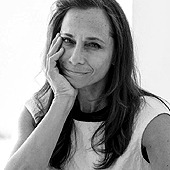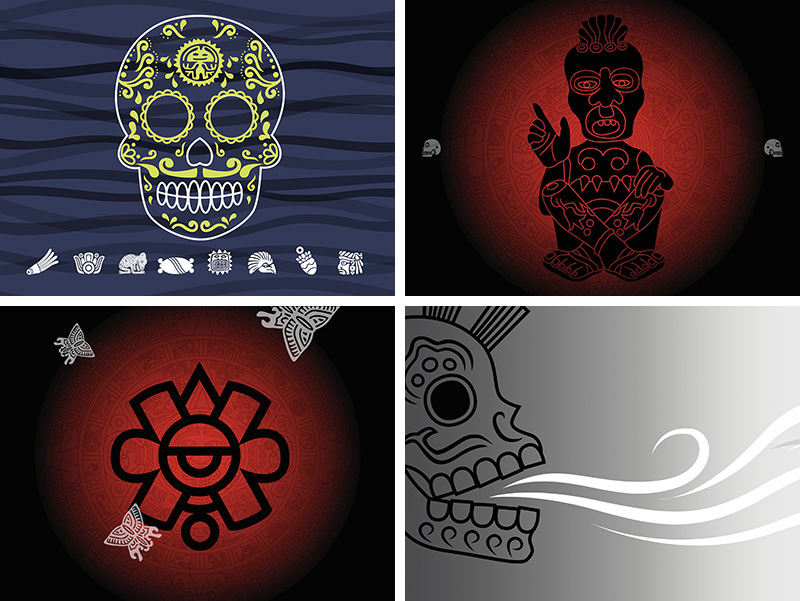
Jessica Helfand|Projects, The Ezra Winter Project
September 1, 2012
Ezra Winter Project: Chapter Nine
As the pilgrim stands on the cliff, unmindful of the rock’s grip already closing upon his feet, a vision of human desires and vanities passes before him: youth and gaiety, plenty and romance; victory and the spoils; and fame. The cloudland swallows them all.
Eugene Klute, Architectural Forum, October 1932
Cloudland
It is now three years after the stock market crash, and while the Depression persists, Ezra Winter has never been busier. Between 1929 and 1931 alone, the artist produces murals for the Birmingham Public Library, The Rochester Savings Bank, Willard Straight Hall at Cornell University, The Union Trust Building in Detroit and the Savarin Restaurant in New York. And then, five days after his forty-sixth birthday, Winter wins a commission to produce a mural in the main lobby of Radio City Music Hall.
Everything is about to change.
Long a darling of the New York Press, Ezra Winter is now a bona fide celebrity. He is photographed around town, spotted at all the finest clubs, quoted in the gossip columns. On July 23, 1932, The New Yorker profiles him in the Talk of the Town.

Winter’s proposed painting is so enormous that he can not paint it in his Grand Central atelier: instead, for $1200, he rents the Pastime Indoor Tennis Club in Long Island City where he and a small team of assistants spend the summer of 1932 working on the canvas rolled out over the floor.

Winter (standing at left, in smock) and his team in the tennis court, 1932
Radio City is the jewel in the crown of John D. Rockefeller’s massive architectural complex, located in an area previously known as “the speakeasy belt”. Winter’s proposal deeply impresses the jury of notable curators and museum directors, including then-director of the Fogg Art Museum at Harvard University Edward Waldo Forbes; Yale University School of Art Dean Everett Meeks; Philadelphia Museum of Art Director Fiske Kimball, and New York Metropolitan Museum of Art Director Herbert E. Winlook.
The artist proposes a project on a then-unprecedented scale, which is to create a 40 x 60-foot mural sweeping the curve of the grand stairway. He imagines a mural based on the eternal quest for the fountain of youth — not the Ponce de Leon expedition but the actual Indian legend — a majestic visual narrative played out against the internal backdrop of an urban palace. In his sketch, Winter proposes mountains and valleys, a march of humanity seeking refuge at the top of a mountain, rich reds the color of natural rock, striations of golden sunlight strategically placed for maximum effect against the shimmering lobby lights.
 Ezra Winter’s mural, entitled The Fountain of Youth, on a linen postcard from the 1930s
Ezra Winter’s mural, entitled The Fountain of Youth, on a linen postcard from the 1930s
In interviews, Winter boldly explains his pragmatic approach. For the first time, he seems to be struggling to identify with a world that is ever becoming more streamlined and simple and new. “It is very modern,” the muralist observes in an interview in The New York Sun, “but very beautiful, and in its way, very simple.”
The press does not concur. Reporting in The New York Times, art critic Edward Alden Jewell (a man who would later claim to be “befuddled” by abstract expressionism) notes that while the mural has been “capably” handled, “a somewhat bolder handling, one that involved, as well, less detail, might have made a more impressive wall.” Jewell goes on to review the additional wall paintings adorning Radio City, including a mural by Stuart Davis for the men’s smoking room on the same floor. Entitled “Men Without Women,” it was based on a book of short stories by Ernest Hemingway. Years later, after it was gifted to the Museum of Modern Art, Davis later renamed it, “mural”.

 Top, final sketch for the Stuart Davis mural., and bottom, a photograph of the mural as it might have looked like when it was newly installed, about 1932
Top, final sketch for the Stuart Davis mural., and bottom, a photograph of the mural as it might have looked like when it was newly installed, about 1932
It is true that in purely formal terms, there is something comparatively modern about Winter’s approach — at least insofar as his earlier work is concerned. The color here is flatter, the lines more self-contained, the use of open space more daring, the essential composition more asymmetrical. There’s also a hint of Art Deco in the general aesthetic sensibility: Winter’s clouds, for example, have a typically 1930’s vignetted quality often seen in illustration from this period.
 Published in 1932 by Chatto and Windus (now an imprint of Random House in the United Kingdom), Aldous Huxley’s Brave New World quickly became an instant classic of science fiction. The cover of the first edition was designed by the English artist Leslie Holland.
Published in 1932 by Chatto and Windus (now an imprint of Random House in the United Kingdom), Aldous Huxley’s Brave New World quickly became an instant classic of science fiction. The cover of the first edition was designed by the English artist Leslie Holland.
Winter’s mural is not so much modern and simple as it is tethered to the exigencies of Nineteenth Century mannerism. While elegant, it is passive: more careful than carefree. Perhaps because its subject matter leans toward the imaginary, it lacks the kind of immediacy and intentionality of his colleague’s work — Davis’s as well as Diego Rivera’s murals. (Rivera’s mural, entitled “Man at the Crossroads”, was later rejected by Rockefeller because of its visible nod to communism. It included a portrait of Lenin.)
 Diego Rivera, Man at the Crossroads, about 1932
Diego Rivera, Man at the Crossroads, about 1932
Unlike the boogie-woogie dynamism of the Davis and Rivera murals, Winter’s tableau projects a dream-like sense of quiet, as though the artist has enveloped himself — in a loose, improvisational sense — in the depiction of the actual myth. It is as if he is that elderly man, standing up on high, looking out at the impossibly capacious gulfs separating him from the rest of the world.

Ezra Winter, The Fountain of Youth, mural detail
It is a chilling metaphor for every contradiction that has come to characterize this artist: from the self-taught painter who has always doubted his own gifts to the eternal romantic whose serial yearning for beauty buffers him from pain, this painting is a testament to — and a celebration of — the paradox of loneliness. Rich in symbolism and nostalgia, it sweeps up the stairs like it is soaring toward the sky, and it is perhaps this one, simple fact that explains everything: once completed, the mural, like the remarkable man who painted it, had nowhere else to go. Struggling to understand the visual appetite of the new century, while emotionally in lock-step with the splendors of the previous one, the artist had arrived at a serious point in his career: nearing Fifty and at the top of his game, he had never felt more conflicted or more alone. The Fountain of Youth would be Ezra Winter’s greatest achievement, an enduring cultural icon in the city he loved — and on every possible level, a simply unsurpassable feat. It is an extraordinary painting precisely because it is so unbearably autobiographical.
Source footage courtesy Cyrus Pinkham Collection, Northeast Historic Film Archive.
Music: Maurice Ravel, Piano Concerto in G, 1932.
Observed
View all
Observed
By Jessica Helfand
Recent Posts
Mine the $3.1T gap: Workplace gender equity is a growth imperative in an era of uncertainty A new alphabet for a shared lived experience Love Letter to a Garden and 20 years of Design Matters with Debbie Millman ‘The conscience of this country’: How filmmakers are documenting resistance in the age of censorship
 Jessica Helfand, a founding editor of Design Observer, is an award-winning graphic designer and writer and a former contributing editor and columnist for Print, Communications Arts and Eye magazines. A member of the Alliance Graphique Internationale and a recent laureate of the Art Director’s Hall of Fame, Helfand received her B.A. and her M.F.A. from Yale University where she has taught since 1994.
Jessica Helfand, a founding editor of Design Observer, is an award-winning graphic designer and writer and a former contributing editor and columnist for Print, Communications Arts and Eye magazines. A member of the Alliance Graphique Internationale and a recent laureate of the Art Director’s Hall of Fame, Helfand received her B.A. and her M.F.A. from Yale University where she has taught since 1994.


